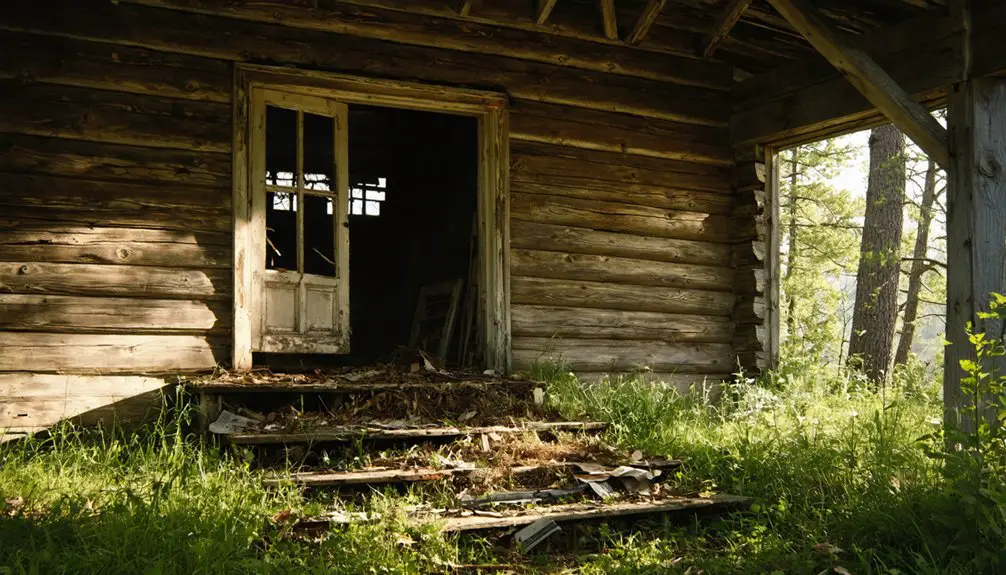You’ll find Askwith’s ghost town remains at 45.616°N, 69.839°W in Maine’s Piscataquis County, where a once-thriving logging settlement flourished in the mid-1800s. The town’s prosperity peaked with the Maine Central Railroad’s arrival in the 1860s, but declined as automobiles replaced rail transport. By the 1930s, only 56 residents remained, and the settlement was renamed Tarratine. Today, ATV trails along former rail corridors trace the footsteps of this forgotten community’s remarkable past.
Key Takeaways
- Askwith was a thriving Maine settlement that declined into a ghost town after its post office closed in 1895 and was renamed Tarratine.
- Located at 45.616°N, 69.839°W in Piscataquis County, the town’s prosperity initially came from abundant timber resources and logging operations.
- The Maine Central Railroad’s decline and the Maine Turnpike’s opening in 1947 contributed significantly to Askwith’s abandonment.
- By the 1930s, only 56 residents remained, surviving through hunting, fishing, and small-scale logging activities.
- Today, Askwith’s former location features an ATV trail along old railroad corridors, with most structures reclaimed by wilderness.
The Rise and Fall of a Maine Settlement
While Askwith began as a promising settlement in Maine’s remote Piscataquis County, its story ultimately became one of decline and abandonment.
Like many frontier towns in rural Maine, Askwith’s early promise faded into the quiet deterioration of a forgotten community.
You’d have found a bustling community built on abundant natural resources – fish, game, and timber that initially sustained the local economy.
The settlement had no connection to the modern Borough of Harrogate that would later govern its English namesake.
The area was later renamed Tarratine and disappeared from modern maps entirely.
But settlement challenges mounted as the logging industry’s decline hit the town hard. By 1895, you’d have witnessed the closure of the post office, a harbinger of things to come.
The railroad line that once connected Askwith to essential commerce was discontinued, and the station fell into disrepair. Resource depletion and harsh environmental conditions took their toll, and by the 1930s, only 56 residents remained.
The town’s transformation into a ghost town was sealed as the railway corridor became an ATV trail, marking Askwith’s final shift from industry to recreation.
Early Days of Promise and Prosperity
As natural resources beckoned early settlers to Maine’s Piscataquis County in the early 1800s, Askwith emerged as a promising settlement between Greenville and Rockwood. You’d have found yourself surrounded by abundant game, fish, and rich forests, offering countless opportunities for those seeking independence through resource management.
The town’s early prosperity centered on timber harvesting, with logging operations providing steady work for skilled woodsmen. You could’ve witnessed the growing community resilience as supporting industries emerged, churches were built, and a train station connected Askwith to broader markets. The establishment of a local post office marked another milestone in the town’s development. By 1895, the community experienced a major setback when the post office closed permanently.
Schools soon followed, cementing the town’s commitment to future generations. The seemingly endless natural bounty drew more settlers, creating a thriving social fabric woven through shared labor and communal institutions.
Railroad’s Role in Town Development
Once the Maine Central Railroad extended its network through Piscataquis County in the 1860s, Askwith’s growth accelerated dramatically.
You’d have seen the railroad impact transform the sleepy village into a bustling hub as the new station became the town’s focal point. The Maine Central’s junction with local logging railroads created essential supply chain connections that revolutionized timber transport from the surrounding forests. After 1911, the Portland Terminal Company consolidated all the local rail yard operations, streamlining freight movements through the region.
The railroad’s presence sparked community growth you couldn’t have imagined before. Local industries flourished as they gained access to broader markets, while steam-powered log haulers and tramways efficiently moved timber to the rail line. The area’s economic development mirrored that of the Boston and Maine Railroad, which had similarly transformed hundreds of New England towns.
You’d have witnessed the town’s prosperity peak when the narrow gauge “Two-Footers” began connecting Askwith to even more remote logging camps, cementing its position as a crucial transportation node.
From Bustling Hub to Abandoned Rails
Despite the railroad’s early prosperity in Askwith, the dawn of the automotive age in the early-to-mid 20th century marked the beginning of the town’s decline. The railway significance diminished as personal vehicles and trucks gained popularity, fundamentally changing the transport evolution of this once-thriving hub.
Like many of Maine’s two-foot gauge railroads, Askwith’s narrow rail lines were eventually abandoned as transportation needs evolved. You’d have witnessed a dramatic shift when the Maine Turnpike opened in 1947, offering a faster route that bypassed Askwith entirely. The town’s businesses shuttered as freight services dwindled, and residents moved away seeking better opportunities. According to Stanford University Press research, this pattern of decline was common among narrow gauge railroad towns throughout America.
Where tracks once carried timber and passengers, you’ll now find only abandoned rail beds and deteriorating station buildings. Some corridors have become recreational trails, while others have surrendered to nature – silent testimonies to Askwith’s former role in Maine’s railway network.
Life in 1930s Askwith
By the 1930s, you’d find only a handful of resilient families in Askwith, mostly connected to the remnants of the timber industry and living in increasing isolation as services and infrastructure continued to deteriorate.
You’d see these last inhabitants relying heavily on hunting, fishing, and small-scale logging operations to sustain themselves, with minimal community interaction beyond immediate family groups.
The population of 56 remained in the area, struggling to maintain their way of life despite the town’s decline.
The abandoned train station and churches stood as stark reminders of the town’s more prosperous past.
If you’d visited during this period, you’d witness the stark reality of a once-thriving town reduced to scattered homesteads among abandoned buildings, as nature gradually reclaimed the surrounding landscape.
Daily Life and Survival
Life in 1930s Askwith centered around basic survival for its remaining 56 residents, who faced significant isolation after the closure of the railway and post office.
You’d find community resilience in how these inhabitants adapted to their circumstances, relying heavily on hunting and fishing for sustenance. Without formal municipal services or active commerce, survival strategies emerged through informal networks and self-sufficiency.
In your daily routine, you’d navigate overgrown roads and abandoned buildings, perhaps trading with neighbors or venturing to nearby towns for essential supplies.
The wooden houses, built during more prosperous times, required constant maintenance against the elements. Many residents turned to subsistence activities, making use of the area’s natural resources – a necessity in a town where formal economic opportunities had vanished with the depleted timber industry.
Last Remaining Families
The remaining families of 1930s Askwith formed a tight-knit but dwindling community, with roughly 56 residents holding onto their homes as the town’s identity shifted from its bustling logging past.
You’d find these last families primarily engaged in subsistence living – hunting wild game, fishing local waters, and tending small farm plots to survive.
Without the logging industry that once sustained them, and the post office long closed since 1895, these hardy residents watched as their neighbors gradually departed for better opportunities elsewhere.
Community bonds remained strong among those who stayed, even as the town’s name changed to Tarratine and their numbers continued to shrink.
The Transition to Tarratine
As you explore Askwith’s changeover to Tarratine in the late 19th century, you’ll notice the name change coincided with the closure of the post office in 1895.
The renaming to Tarratine marked a significant shift in the town’s identity, reflecting both the area’s Native American heritage and its evolution from an active settlement to a ghost town.
You can still find references to both names in historical records, though Tarratine became the officially recognized designation for this remote location in Piscataquis County.
Name Change Origins
While records remain unclear about the exact timing, Askwith’s changeover to its new name “Tarratine” occurred during a period of significant decline, when the town’s post office had already closed in 1895 and its railroad station ceased operations.
The name significance stems from the Tarratine Indians, who were part of the Penobscot tribe native to Maine. You’ll find this cultural heritage deeply rooted in the region’s history, particularly through Baron Jean-Vincent d’Abbadie de Saint-Castin’s trading relationships with the Tarratine Indians in the late 17th century.
This indigenous connection lives on today through place names like Tarratine Street in Castine, Maine. The renaming likely represented an effort to honor the area’s native history while rebranding the declining settlement.
Legacy of Two Names
Two distinct identities marked this Maine settlement’s historical record, with Askwith’s legacy persisting in ghost town listings even as Tarratine became the official geographic designation.
You’ll find both names referenced in historical documents, though the alteration created challenges in dating the town’s abandonment accurately.
The name significance extends beyond administrative changes, as Tarratine reflects Maine’s Native American cultural heritage, particularly the Wabanaki tribes.
While you won’t see Askwith on modern maps, its memory lives on through historical research and ghost town documentation.
The change illustrates broader conversations about Indigenous recognition in place naming.
Current records typically use Tarratine for geographic reference but acknowledge Askwith’s original identity, preserving both chapters of the settlement’s story.
A Ghost Town’s Legacy Today

Though Askwith’s buildings have largely vanished into Maine’s wilderness, its legacy lives on through the repurposed railroad corridor that now serves as a popular ATV trail.
You’ll find this ghost town‘s spirit preserved in Piscataquis County between Greenville and Rockwood, where recreational opportunities attract outdoor enthusiasts seeking adventure along the historic pathways.
While you won’t spot Askwith on modern maps – it’s now known as Tarratine – the area’s cultural memory endures through its transformation from a bustling resource town to a reflection of Maine’s evolving landscape.
The site, positioned near Misery Knob at 45.616°N, 69.839°W, tells the story of shifting economies and adaptation.
Where logging operations and a post office once thrived, nature has reclaimed most structures, leaving behind a quiet reminder of Maine’s dynamic history.
Frequently Asked Questions
Are There Any Remaining Structures Still Standing in Askwith Today?
You won’t find any remaining buildings standing in Askwith today – only foundations and rock walls mark its historical significance, with most structures having vanished through decades of abandonment and decay.
What Happened to the Families Who Left Askwith During Its Decline?
Due to economic decline, you’ll find that families primarily migrated to nearby mining towns and industrial centers seeking work, though exact relocation records haven’t survived to track each family’s specific destination.
Was There a School or Church Established in Askwith?
You won’t find documented school history or church significance in historical records of Askwith. The town’s brief existence and small population likely meant residents relied on neighboring communities for these services.
What Native Wildlife Can Still Be Found Around the Ghost Town?
You’ll spot over 30 wildlife species thriving in the ghost town’s rewilded landscape, from bald eagles nesting near rivers to white-tailed deer, black bears, and smallmouth bass in surrounding waters.
Can Visitors Legally Explore the Askwith Ghost Town Site?
You’ll need to be cautious since ghost town regulations aren’t clear. While the ATV trail’s public, exploring off-trail requires landowner permission. For visitor safety, stick to established paths and respect posted signs.
References
- https://en.wikipedia.org/wiki/Askwith
- https://au.hotels.com/go/usa/ghost-towns-maine
- https://newenglandwithlove.com/ghost-towns-in-maine/
- https://www.mooseriverlookout.com/post/ghost-towns-in-maine-9-fascinating-places-that-rose-fell
- https://b985.fm/6-maine-ghost-towns-you-never-knew-existed/
- https://kids.kiddle.co/List_of_ghost_towns_in_Maine
- https://nz.hotels.com/go/usa/ghost-towns-maine
- https://da.hotels.com/go/usa/ghost-towns-maine
- http://freepages.rootsweb.com/~gtusa/history/usa/me.htm
- https://www.youtube.com/watch?v=C6EQHVBSLcw



